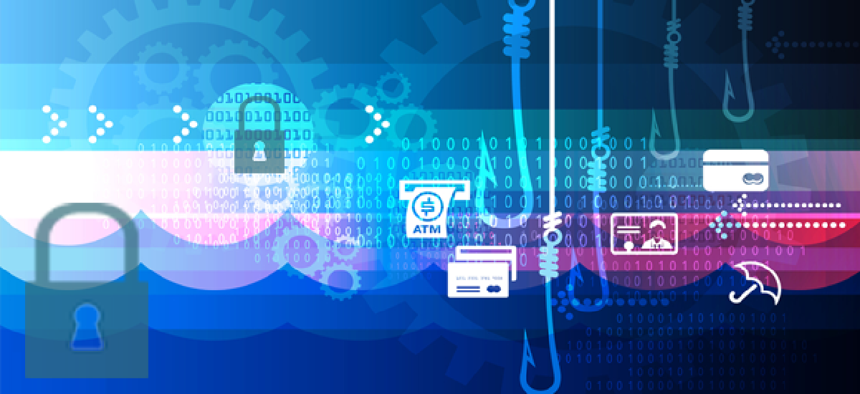Extending cybersecurity to fraud analytics


Connecting state and local government leaders
While there are some similarities between cybersecurity and fraud, traditional cybersecurity monitoring and analytics must evolve in order to identify the fraudulent use of IT systems that may otherwise go unnoticed.
Information security leaders often defend against cyber threats by focusing on traditional IT tools and techniques -- firewalls, intrusion detection and prevention systems, malware detection and analysis and the like. As organizations have locked down systems with more sophisticated defense-in-depth technical controls, adversaries have evolved to take advantage of information systems by impersonating regular users. While there are some similarities between cybersecurity and fraud, traditional cybersecurity monitoring and analytics must evolve in order to identify the fraudulent use of IT systems that may otherwise go unnoticed.
Two recent high-profile incidents at federal agencies illustrate the difference between a traditional cybersecurity event and criminal activity based on fraud. In 2015, the Office of Personnel Management disclosed two separate but related cybersecurity incidents in which background investigation records and personnel data for millions of current and former federal employees had been stolen. This sophisticated attack involved stealing credentials and gaining unauthorized access to the OPM network after planting malware and creating a backdoor for data exfiltration. This intrusion into OPM’s systems and networks – which fits the pattern of nation-state activity and the mold of a traditional cybersecurity incident -- resulted in likely the most damaging network intrusion and data breach in U.S. history.
Also in 2015, the IRS disclosed an incident involving its Get Transcript web application in which taxpayer data for hundreds of thousands of citizens was potentially exposed. However, unlike the OPM incident, no IRS systems or networks were actually compromised. Rather, criminals used information they had already obtained from other outside sources to impersonate taxpayers. They used the Get Transcript application as it was designed to obtain transcripts of taxpayer returns from prior years. While the result was similar in that sensitive information made it into the hands of criminals, this was not a cybersecurity attack detectable via traditional tools or techniques. No malware was involved, there was no system or network intrusion and any taxpayer data returned to fraudsters was done so as if they were the actual taxpayer using the system as designed.
While improvements to traditional cybersecurity defenses can combat the type of attack seen against OPM, those same techniques will not prevent or detect fraud and the misuse of systems as seen in the IRS event. Detecting fraud requires a different mindset and a different type of analyst. Even highly-skilled cybersecurity analysts who can reverse-engineer malware and analyze network packets will be unable to detect fraudulent activity in which no malware or network compromise occurs. Similarly, neither network defense tools such as firewalls, intrusion detection systems or anti-virus (nor the security events generated by these tools) will detect or identify the type of attack seen against the IRS Get Transcript application. These tools rely on identifying known malicious files or defined signatures of traffic attempting to exploit known system or network vulnerabilities. Detecting and preventing fraud, on the other hand, requires an in-depth knowledge of the expected user activity and behaviors that will not be part of common signature sets from security vendors.
Both types of attacks take advantage of IT's inherent struggle between usability and security. In the case of the OPM breach, the background investigation and personnel systems provided an online repository and workflow for processing this critical information. The IRS Get Transcript application used an authentication mechanism intended to be strong enough to validate taxpayer identities while offering convenience and minimizing the taxpayer burden.
There is no silver bullet technology or capability that can prevent or detect fraud. Organizations must start by establishing a baseline of normal and valid user activities for their systems. By first understanding the intricacies of the business and expected user behavior, organizations can begin to identify atypical behavior. This analysis may include session rates or lengths, transaction velocity, geographic location and time or date anomalies.
Fraud analytics must be supported by individuals with specialized backgrounds in mathematics, data modeling and statistics in order to be effective. Once thresholds for relevant behaviors have been identified, it may be possible to leverage traditional security information and event management tools for correlation, monitoring and reporting of fraud from new data sources. If existing tools cannot support fraud analytics, specialized fraud detection technologies or external services may be added to the overall organizational security architecture.
Fraud analytics requires a change in mindset from traditional cybersecurity monitoring, but it must still be a coordinated effort by the IT team or an extension of traditional security operations center teams. With the right skillsets and level of attention on fraud analytics, organizations can further advance their overall cybersecurity capabilities to detect and ultimately prevent the new fraud and impersonation techniques criminals are more frequently using to bypass traditional enterprise cybersecurity defenses.
NEXT STORY: DOD to eliminate common access cards




